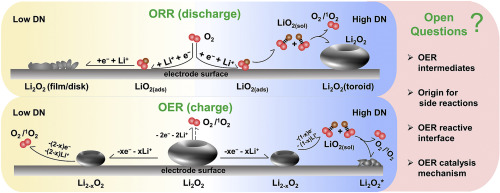Energy Storage Materials ( IF 18.9 ) Pub Date : 2020-03-12 , DOI: 10.1016/j.ensm.2020.03.007 Yu Wang , Yi-Chun Lu

|
Nonaqueous lithium–oxygen (Li–O2) batteries have received intensive research attention owing to their potential to provide gravimetric energy density 2–5 times that of conventional Li-ion batteries. However, Li–O2 batteries are suffering from poor cycle life, low rate capability and poor round-trip efficiency. In-depth understanding on the reaction and degradation mechanism is the prerequisite for rational electrode and electrolyte design for efficient and long-life Li–O2 batteries. In this review, we analyze recent progress in oxygen reduction reaction (ORR) and oxygen evolution reaction (OER) mechanism. We discuss on-going debates and open questions related to OER processes including the reaction intermediates, the origin for the side reactions, the reaction interface and the catalysis mechanism. We provide insights into the sources of discrepancies and highlight future research directions in deepening the understanding of Li–O2 reactions and strategies in mitigating the severe instability between the reaction intermediates and cell components for efficient and long-life Li–O2 batteries.
中文翻译:

非水锂氧电池:反应机理和关键性开放性问题
非水锂-氧(Li-O 2)电池由于其提供的重量能量密度是传统锂离子电池的2-5倍,因此备受研究关注。但是,Li-O 2电池的循环寿命短,倍率能力低和往返效率差。对反应和降解机理的深入了解是合理设计电极和电解质以实现高效长寿命Li–O 2的前提。电池。在这篇综述中,我们分析了氧还原反应(ORR)和氧释放反应(OER)机理的最新进展。我们讨论与OER过程相关的持续辩论和开放性问题,包括反应中间体,副反应的起源,反应界面和催化机理。我们提供了差异来源的见解,并着重指出了未来的研究方向,以加深对Li-O 2反应的了解,并减轻了有效和长寿命Li-O 2电池的反应中间体和电池组件之间的严重不稳定性。











































 京公网安备 11010802027423号
京公网安备 11010802027423号